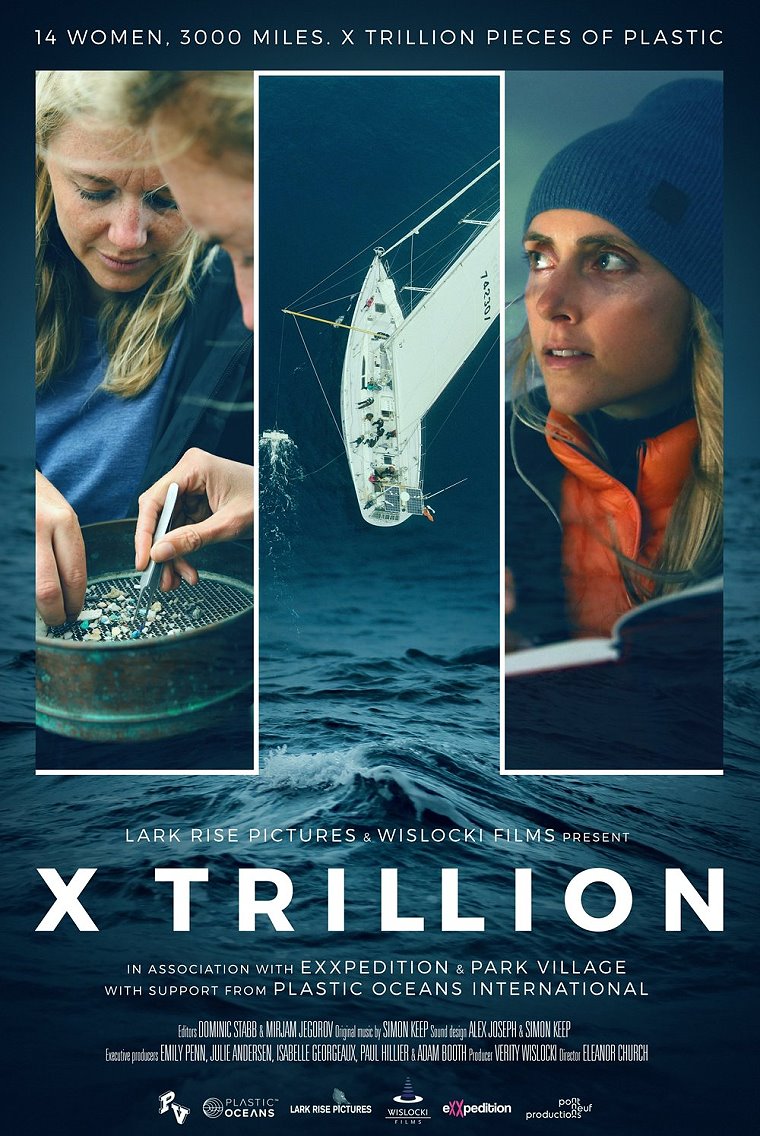 The documentary X-Trillion shows the journey of 14 women crossing the North Pacific Ocean in a sailing ship to document at least the surface plastic that has been dubbed the Great Pacific Garbage Patch. The eXXpedition’s all-women crew led by Emily Penn sailed 3,000 miles taking samples to make the unseen, seen. The film was projected as part of the Ocean Weak in the cinema ‘Aventure’ in the centre of Brussels on 1 October. The 14-strong international crew of scientists, sailors, designers, engineers, and teachers set sail on a transformative almost one month-long voyage. The women leave families and land behind, coming together battling high seas, storms and sea sickness, to carry out sampling for microplastics research that casts some light on the crisis of ubiquitous plastic pollution that has even reached significant dimensions in this remote place on Earth, far from land and ‘civilisation’.
The documentary X-Trillion shows the journey of 14 women crossing the North Pacific Ocean in a sailing ship to document at least the surface plastic that has been dubbed the Great Pacific Garbage Patch. The eXXpedition’s all-women crew led by Emily Penn sailed 3,000 miles taking samples to make the unseen, seen. The film was projected as part of the Ocean Weak in the cinema ‘Aventure’ in the centre of Brussels on 1 October. The 14-strong international crew of scientists, sailors, designers, engineers, and teachers set sail on a transformative almost one month-long voyage. The women leave families and land behind, coming together battling high seas, storms and sea sickness, to carry out sampling for microplastics research that casts some light on the crisis of ubiquitous plastic pollution that has even reached significant dimensions in this remote place on Earth, far from land and ‘civilisation’.

 The viewer sees the daily struggle of the mottled crew to come to grips with the strict safety and work routines on board and dive deeper into understanding the scale of the pollution, what it does to marine life and ultimately to us, but also what can be done about it. The discussion afterwards with Director Eleanor Church, representatives of NGOs, researchers and European Commission increased the appreciation of the film significantly. As more and more detail and context are provided in the conversation among the panelists and with the audience, the challenge gets new contours. The scale of the plastic contamination is almost unfathonable and once in the ocean it gets transported into every last corner by the currents without a realistic chance to eliminate it from there. Having said that, the sailing women with their diverse backgrounds already come up with some ideas what to do, including making sure that lost or discarded fishing gear gets picked up rather than serving as a poisonous shelter and support for juvenile fish and diverse stow aways. Being acutely aware of the fact that larger plastic not only breaks up under the combined effect of waves and radiation in surface waters and that thus release toxic chemicals, the surfaces also attract other molecules, bacteria and viruses which will be ingested by larger animals mistaking the plastic for food. It is thus urgent to prevent plastic from reaching the ocean and other waterways in the first place.
The viewer sees the daily struggle of the mottled crew to come to grips with the strict safety and work routines on board and dive deeper into understanding the scale of the pollution, what it does to marine life and ultimately to us, but also what can be done about it. The discussion afterwards with Director Eleanor Church, representatives of NGOs, researchers and European Commission increased the appreciation of the film significantly. As more and more detail and context are provided in the conversation among the panelists and with the audience, the challenge gets new contours. The scale of the plastic contamination is almost unfathonable and once in the ocean it gets transported into every last corner by the currents without a realistic chance to eliminate it from there. Having said that, the sailing women with their diverse backgrounds already come up with some ideas what to do, including making sure that lost or discarded fishing gear gets picked up rather than serving as a poisonous shelter and support for juvenile fish and diverse stow aways. Being acutely aware of the fact that larger plastic not only breaks up under the combined effect of waves and radiation in surface waters and that thus release toxic chemicals, the surfaces also attract other molecules, bacteria and viruses which will be ingested by larger animals mistaking the plastic for food. It is thus urgent to prevent plastic from reaching the ocean and other waterways in the first place.
Eleanor Church explained in the light of these findings how much care went into post-production and cutting the film in a way that the public would get some insights into the plastic crisis, but in a way that emphasises what we can do against it celebrating hope and cooperation. Let this spirit imbue the negotiators of a legally binding treaty to curb plastic use and pollution to cure the planet from this disease. Click here to get more information from the website of the film producers. Interested in more background about the plastic economy? The currently dominant production process of multiple forms of plastic is linear: fossil fuels as raw material, production of object, discard as waste. A scientific assessment of the very ambitious measures considered necessary to turn this into a circular process was recently published as an open access article in the journal Nature: Vidal, F., van der Marel, E.R., Kerr, R.W.F. et al. Designing a circular carbon and plastics economy for a sustainable future. Nature 626, 45–57 (2024). https://doi.org/10.1038/s41586-023-06939-z
